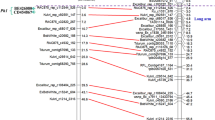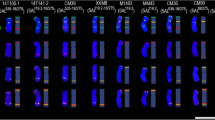Abstract
During sexual propagation of primary trisomic 8, chromosome 8 breaks in some rice plants, resulting in a telotrisomic (2n+·8S) line. In this study, we observed that the extra short arm of chromosome 8 (·8S) can easily be lost in the telotrisomic, and we determined by fluorescence in-situ hybridization (FISH) analysis that the centromeric region of the extra ·8S did not contain the rice centromeric satellite repeat (CentO) and centromere-specific retrotransposon (CRR); however, the extra ·8S contained part of the CentO and CRR sequences in the initially preserved telotrisomic line. We confirmed by real-time quantitative PCR (RQ-PCR) analysis that the original functional centromere of the extra ·8S was lost. Using both FISH and RQ-PCR, the breakage point of the extra ·8S was found within the BAC clone a0070J19 sequence containing the first part of the short arm near the centromere region of chromosome 8 but without any CentO or CRR sequences. However, part of the DNA sequence within the a0070J19 BAC clone played a role in the new functional centromere, contributing to the morphological variations by asexually propagated plants of rice telotrisomics in the field. We conclude that CENH3, a key element in the eukaryotic kinetochore, may not always bind properly with the new functional centromere, resulting in loss of the extra ·8S during mitosis and the chromosome numbers returning to diploid levels in subsequent generations.




Similar content being viewed by others
Abbreviations
- BAC:
-
bacterial artificial chromosome
- CentO:
-
centromeric satellite repeat
- CRR:
-
centromere-specific retrotransposon
- DAPI:
-
4′,6-diamidinophenylindole
- FISH:
-
fluorescence in-situ hybridization
- FITC:
-
fluorescein isothiocyanate
- PMC:
-
pollen mother cell
- RQ-PCR:
-
real-time quantitative PCR
References
Amor DJ, Choo KH (2002) Neocentromeres: role in human disease, evolution, and centromere study. Am J Hum Genet 71:695–714
Amor DJ, Kalitsis P, Sumer H, Choo KH (2004) Building the centromere: from foundation proteins to 3D organization. Trends Cell Biol 14:359–368
Ananiev EV, Phillips RL, Rines HW (1998) Chromosome-specific molecular organization of maize (Zea mays L.) centromeric regions. Proc Natl Acad Sci USA 95:13073–13078
Blower MD, Karpen GH (2001) The role of Drosophila CID in kinetochore formation, cell-cycle progression and heterochromatin interactions. Nat Cell Biol 3:730–739
Cheeseman IM, Drubin DG, Barnes G (2002) Simple centromere, complex kinetochore: linking spindle microtubules and centromeric DNA in budding yeast. J Cell Biol 157:199–203
Cheng Z, Presting GG, Buell CR, Wing RA, Jiang J (2001a) High-resolution pachytene chromosome map** of bacterial artificial chromosomes anchored by genetic markers reveals the centromere location and the distribution of genetic recombination along chromosome 10 of rice. Genetics 157:1749–1757
Cheng Z, Yan H, Yu H et al (2001b) Development and applications of a complete set of rice telotrisomics. Genetics 157:361–368
Cheng Z, Dong F, Langdon T et al (2002) Functional rice centromeres are marked by a satellite repeat and a centromere-specific retrotransposon. Plant Cell 14:1691–1704
Choo KH (2001) Domain organization at the centromere and neocentromere. Dev Cell 1:165–177
Clarke L, Carbon J (1983) Genomic substitutions of centromeres in Saccharomyces cerevisiae. Nature 305:23–28
Henikoff S, Ahmad K, Malik HS (2001) The centromere paradox: stable inheritance with rapidly evolving DNA. Science 293:1098–1102
Hosouchi T, Kumekawa N, Tsuruoka H, Kotani H (2002) Physical map-based sizes of the centromeric regions of Arabidopsis thaliana chromosomes 1, 2, and 3. DNA Res 9:117–121
Houben A, Schubert I (2003) DNA and proteins of plant centromeres. Curr Opin Plant Biol 6:554–560
Howman EV, Fowler KJ, Newson AJ et al (2000) Early disruption of centromeric chromatin organization in centromere protein A (Cenpa) null mice. Proc Natl Acad Sci USA 97:1148–1153
Jiang J, Gill BS, Wang GL, Ronald PC, Ward DC (1995) Metaphase and interphase fluorescence in situ hybridization map** of the rice genome with bacterial artificial chromosomes. Proc Natl Acad Sci USA 92:4487–4491
Kamm A, Galasso I, Schmidt T, Heslop-Harrison JS (1995) Analysis of a repetitive DNA family from Arabidopsis arenosa and relationships between Arabidopsis species. Plant Mol Biol 27:853–862
Kumekawa N, Hosouchi T, Tsuruoka H, Kotani H (2000) The size and sequence organization of the centromeric region of Arabidopsis thaliana chromosome 5. DNA Res 7:315–321
Kumekawa N, Hosouchi T, Tsuruoka H, Kotani H (2001) The size and sequence organization of the centromeric region of Arabidopsis thaliana chromosome 4. DNA Res 8:285–290
Kurata N, Omura T (1978) Karyotype analysis in rice I. A new method for identifying all chromosome pairs. Jpn J Genet 53:251–255.
Larkin PJ, Scowcroft WP (1981) Somaclonal variation novel source of variability from cell culture for plant improvement. Theor Appl Genet 60:197–214
Lermontova I, Schubert V, Fuchs J, Klatte S, Macas J et al (2006) Loading of Arabidopsis centromeric histone CENH3 occurs mainly during G2 and requires the presence of the histone fold domain. Plant Cell 18:2443–2451
Ma J, Jackson SA (2006) Retrotransposon accumulation and satellite amplification mediated by segmental duplication facilitate centromere expansion in rice. Genome Res 16:251–259
Maggert KA, Karpen GH (2001) The activation of a neocentromere in Drosophila requires proximity to an endogenous centromere. Genetics 158:1615–1628
Malik HS, Henikoff S (2002) Conflict begets complexity: the evolution of centromeres. Curr Opin Genet Dev 12:711–718
Nagaki K, Cheng Z, Ouyang S et al (2004) Sequencing of a rice centromere uncovers active genes. Nat Genet 36:138–145
Nagaki K, Kashihara K, Murata M (2009) A centromeric DNA sequence colocalized with a centromere-specific histone H3 in tobacco. Chromosoma 118:249–257
Nasuda S, Hudakova S, Schubert I, Houben A, Endo TR (2005) Stable barley chromosomes without centromeric repeats. Proc Natl Acad Sci USA 102:9842–9847
Ngezahayo F, Dong Y, Liu B (2007) Somaclonal variation at the nucleotide sequence level in rice (Oryza sativa L.) as revealed by RAPD and ISSR markers, and by pairwise sequence analysis. J Appl Genet 48:329–336
Palmer DK, O’Day K, Wener MH, Andrews BS, Margolis RL (1987) A 17-kD centromere protein (CENP-A) copurifies with nucleosome core particles and with histones. J Cell Biol 104:805–815
Palmer DK, O’Day K, Trong HL, Charbonneau H, Margolis RL (1991) Purification of the centromere-specific protein CENP-A and demonstration that it is a distinctive histone. Proc Natl Acad Sci USA 88:3734–3738
Richards EJ, Ausubel FM (1988) Isolation of a higher eukaryotic telomere from Arabidopsis thaliana. Cell 53:127–136
Schueler MG, Higgins AW, Rudd MK, Gustashaw K, Willard HF (2001) Genomic and genetic definition of a functional human centromere. Science 294:109–115
Sullivan BA, Blower MD, Karpen GH (2001) Determining centromere identity: cyclical stories and forking paths. Nat Rev Genet 2:584–596
Sun X, Wahlstrom J, Karpen G (1997) Molecular structure of a functional Drosophila centromere. Cell 91:1007–1019
Talbert PB, Masuelli R, Tyagi AP, Comai L, Henikoff S (2002) Centromeric localization and adaptive evolution of an Arabidopsis histone H3 variant. Plant Cell 14:1053–1066
Tanaka TU (2008) Bi-orienting chromosomes: acrobatics on the mitotic spindle. Chromosoma 117:521–533
Thomas JW, Schueler MG, Summers TJ et al (2003) Pericentromeric duplications in the laboratory mouse. Genome Res 13:55–63
Vafa O, Sullivan KF (1997) Chromatin containing CENP-A and alpha-satellite DNA is a major component of the inner kinetochore plate. Curr Biol 7:897–900
Warburton PE (2004) Chromosomal dynamics of human neocentromere formation. Chromosome Res 12:617–626
Warburton PE, Cooke CA, Bourassa S et al (1997) Immunolocalization of CENP-A suggests a distinct nucleosome structure at the inner kinetochore plate of active centromeres. Curr Biol 7:901–904
Wevrick R, Willard HF (1989) Long-range organization of tandem arrays of alpha satellite DNA at the centromeres of human chromosomes: high-frequency array-length polymorphism and meiotic stability. Proc Natl Acad Sci USA 86:9394–9398
Wu HK (1967) Note on preparing of pachytene chromosomes by double mordant. Sci Agric 15:40–44
Yan H, ** W, Nagaki K et al (2005) Transcription and histone modifications in the recombination-free region spanning a rice centromere. Plant Cell 17:3227–3238
Yang H, Tabei Y, Kamada H, Kayano T, Takaiwa F (1999) Detection of somaclonal variation in cultured rice cells using digoxigenin-based random amplified polymorphic DNA. Plant Cell Rep 18:520–526
Yu HX, Wang X, Gong ZY et al (2008) Generating of rice OsCENH3-GFP transgenic plants and their genetic applications. Chin Sci Bull 53:2981–2988
Zhang W, Yi C, Bao W et al (2005) The transcribed 165-bp CentO satellite is the major functional centromeric element in the wild rice species Oryza punctata. Plant Physiol 139:306–315
Acknowledgements
We are grateful to Zhukuan Cheng for critical reading of the manuscript and Yong Zhou for RQ-PCR analysis. This work was supported by grants from the National Natural Science Foundation of China (30600345 and 30770131).
Author information
Authors and Affiliations
Corresponding author
Additional information
Responsible Editor: Jiming Jiang.
Rights and permissions
About this article
Cite this article
Gong, Z., Yu, H., Huang, J. et al. Unstable transmission of rice chromosomes without functional centromeric repeats in asexual propagation. Chromosome Res 17, 863–872 (2009). https://doi.org/10.1007/s10577-009-9073-7
Received:
Revised:
Accepted:
Published:
Issue Date:
DOI: https://doi.org/10.1007/s10577-009-9073-7




